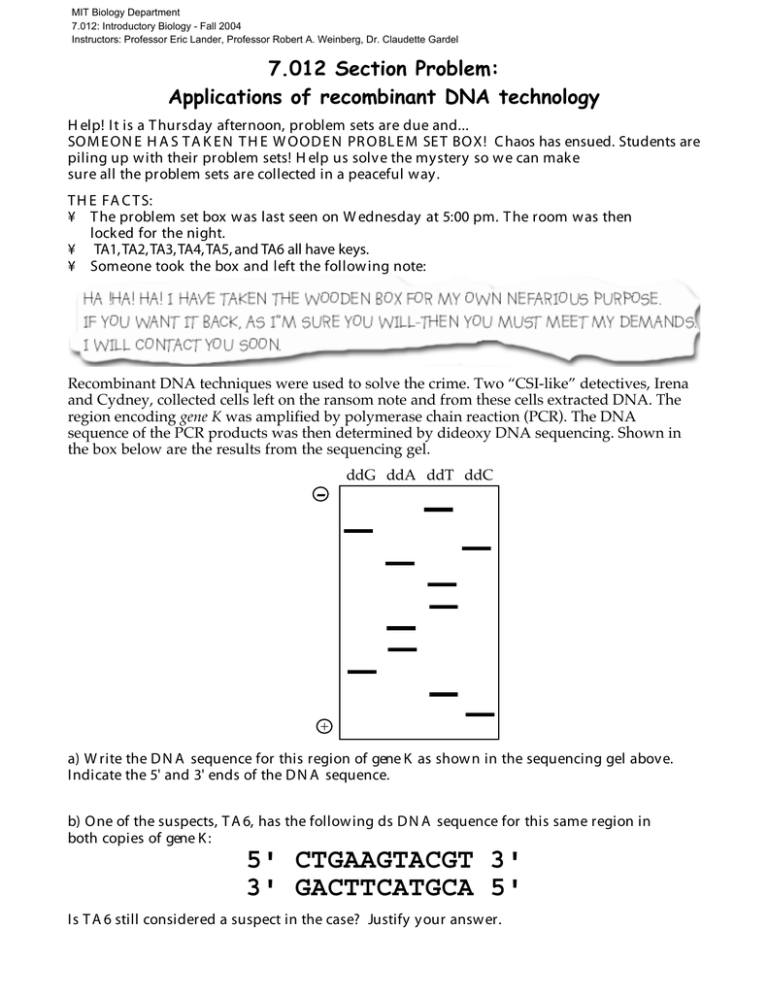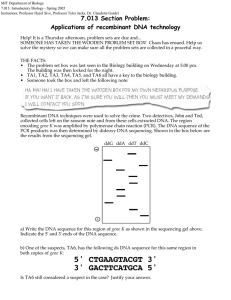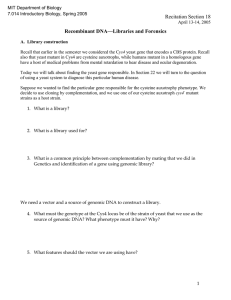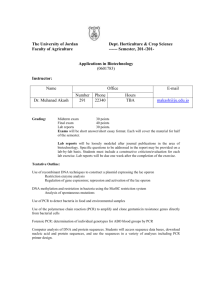Document 13478135
advertisement

MIT Biology Department 7.012: Introductory Biology - Fall 2004 Instructors: Professor Eric Lander, Professor Robert A. Weinberg, Dr. Claudette Gardel 7.012 Section Problem: Applications of recombinant DNA technology H elp! It is a T hursday afternoon, problem sets are due and... SOM E ON E H A S T A K E N T H E W OODE N PR OBL E M SE T BOX! C haos has ensued. Students are piling up with their problem sets! H elp us solve the mystery so we can make sure all the problem sets are collected in a peaceful way. T H E FA C T S: ¥ T he problem set box was last seen on W ednesday at 5:00 pm. T he room was then locked for the night. ¥ TA1, TA2, TA3, TA4, TA5, and TA6 all have keys. ¥ Someone took the box and left the follow ing note: Recombinant DNA techniques were used to solve the crime. Two “CSI-like” detectives, Irena and Cydney, collected cells left on the ransom note and from these cells extracted DNA. The region encoding gene K was amplified by polymerase chain reaction (PCR). The DNA sequence of the PCR products was then determined by dideoxy DNA sequencing. Shown in the box below are the results from the sequencing gel. - ddG ddA ddT ddC + a) W rite the D N A sequence for this region of gene K as shown in the sequencing gel above. Indicate the 5' and 3' ends of the D N A sequence. b) One of the suspects, T A 6, has the following ds D N A sequence for this same region in both copies of gene K : 5' CTGAAGTACGT 3' 3' GACTTCATGCA 5' Is T A 6 still considered a suspect in the case? Justify your answer. Sarah, the detective analyzed a second site, the gene L locus (represented by the shaded box below), which she has shown is useful for forensics. The only difference between the two alleles at this locus is that the l allele lacks an internal EcoRI restriction site present in the L allele. EcoRI L allele: l allele: Cydney, the codetective, performed PCR analysis of the cells taken from the note and determined that the note was handled only by a Ll individual. Based on this, the gene L locus of the suspects was amplified by PCR, the PCR products were digested with EcoRI, and the resulting fragments were separated by agarose gel electrophoresis as shown below: TA1 Chris TA4 Dina TA5 Piyush TA3T. Mike TA2 Lynne Larger fragments Smaller fragments – + genotype: c) In the spaces provided above, indicate the genotypes at the gene L locus for these suspects. d) Based on the PCR analysis of the gene L locus, which individual(s) can be excluded as suspects in the crime? Justify your answer. A t chromosomal position Z , it is common to find one or more copies of a 100 bp insert. Fortunately , many of the suspects hav e different number of inserts at this position: T A 2 has no inserts. T A 5 has one insert. T A 3 has tw o inserts. T A 4 has three inserts. T A 1 has four inserts. T A 6 has tw o inserts. A partial D N A sequence of position Z is giv en below . T he length of position Z w ithout an insert is 2000 bp. 5'-GTGCA.... ....CGACG-3' 100 bp insert 3'-CACGT.... n....GCTGC-5' [ ] e) To determine who stole the problem set box, design a PCR-based strategy to analyze position Z, including the sequences and orientation (5' and 3' ends) of two 5-base primers necessary to PCR amplify this region. Sample from bag Molecular weight standards in bp f) The following pattern was seen by Jim, the DNA technical expert, on the gel used to separate the PCR products from the above experiment i) Which lane corresponds to which individual? ii) Cydney, the detective says “I know who did it.” Who committed this heinous crime?









